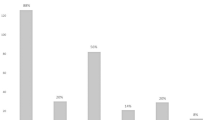Abstract
Introduction
Ineffective esophageal motility (IEM) is a physiologic diagnosis and is a component of the Chicago Classification. It has a strong association with gastroesophageal reflux and may be found during work-up for anti-reflux surgery. IEM implies a higher risk of post-op dysphagia if a total fundoplication is done. We hypothesized that IEM is not predictive of dysphagia following fundoplication and that it is safe to perform total fundoplication in appropriately selected patients.
Methods
Retrospective chart review of patients who underwent total fundoplication between September 2012 and December 2018 in a single foregut surgery center and who had IEM on preoperative manometry. We excluded patients who had partial fundoplication, previous foregut surgery, other causes of dysphagia or an esophageal lengthening procedure. Dysphagia was assessed using standardized Dakkak score ≤ 40 and GERD-HRQL question 7 ≥ 3.
Results
Two hundred patients were diagnosed with IEM and 31 met the inclusion criteria. Median follow-up: 706 days (IQR 278–1348 days). No preoperative factors, including subjective dysphagia, transit on barium swallow, or individual components of manometry showed statistical correlation with postoperative dysphagia. Of 9 patients with preoperative dysphagia, 2 (22%) had persistent postoperative dysphagia and 7 had resolution. Of 22 patients without preoperative dysphagia, 3 (14%) developed postoperative dysphagia; for a combined rate of 16%. No patient needed re-intervention beyond early recovery or required reoperation for dysphagia during the follow-up period.
Conclusion
In appropriately selected patients, when total fundoplication is performed in the presence of preoperative IEM, the rate of long-term postoperative dysphagia is similar to the reported rate of dysphagia without IEM. With appropriate patient selection, total fundoplication may be performed in patients with IEM without a disproportionate increase in postoperative dysphagia. The presence of preoperative IEM should not be rigidly applied as a contraindication to a total fundoplication.





Similar content being viewed by others
References
Kahrilas P, Bredenoord A, Fox M et al (2016) The Chicago classification of esophageal motility disorders v3.0. Neurogastroenterol Motil 27(2):160–174
Abdel JA, Castell D (2015) Ineffective esophageal motility (IEM): the old-new frontier in esophagology. Curr Gastroenterol Rep 18(1):1–7
Diener U, Patti M, Molena D et al (2001) Esophageal dysmotility and gastroesophageal reflux disease. J Gastrointest Surg 5(3):260–265
Shelter K, Bikhtii S, Triadafilopoulos G (2017) Ineffective esophageal motility: clinical manometric, and outcome characteristics in patients with and without abnormal esophageal acid exposure. Dis Esophagus 30(6):1–8
Shemmeri E, Aye R, Farivar AS et al. (2019) Use of a report card to evaluate outcomes of achalasia surgey: beyond the Eckardt score. Surg Endosc 34(4):1856–1862
Robinson B, Dunst C, Cassera M et al (2015) 20 Years later : laparoscopic fundoplication durability. Surg Endosc 29(9):2520–2524
Maziak D, Todd T, Pearson F (1998) Massive hiatus hernia: evaluation and surgical management. Thorac Cardiovasc Surg 115:53–62
Targarona E, Grislaes S, Uyanik O et al (2013) Long-term outcome and quality of life after laparoscopic treatment of large paraesophageal hernia. World J Surg 37(8):1878–1882
Mello M, Shriver A, Li Y et al (2016) Ineffective esophageal motility phenotypes following fundoplication in gastroesophageal reflux disease. Neurogastroenterol Motil 28:292–298
Backos C, Petrov R, Parkman H et al (2019) Role and safety of fundoplication in oesophageal disease and dysmotility disorder syndrome. J Thorac Dis 11(S12):S1610–1617
Kapadia S, Osler T, Lee A et al (2018) The role of preoperative high resolution manometry in predicting dysphagia after laparoscopic Nissen Fundoplication. Surg Endosc 32:2365–2372
Booth MI, Stratford J, Jones L et al (2008) Randomized clinical trial of laparoscopic total (Nissen) versus posterior partial (Toupet) Fundoplication for gastro-oesophageal reflux disease based on preoperative oesophageal manometry. Br J Surg 96:57–63
Hasak S, Brint L, Wand D et al (2019) Clinical characteristics and outcomes of patients with postfundoplication dysphagia. Clin Gastroenterol Hepatol 17:1982–1990
Author information
Authors and Affiliations
Corresponding author
Ethics declarations
Disclosures
Dr. Louie reports and received restricted research Grants from Torax Medical in the past (> 36 months). Dr. Laliberte, Dr. Wilshire, Dr. Farivar, Dr. Bograd and Dr. Aye have no conflicts of interest or financial ties to disclose.
Additional information
Publisher's Note
Springer Nature remains neutral with regard to jurisdictional claims in published maps and institutional affiliations.
Rights and permissions
About this article
Cite this article
Laliberte, AS., Louie, B.E., Wilshire, C.L. et al. Ineffective esophageal motility is not a contraindication to total fundoplication. Surg Endosc 35, 4811–4816 (2021). https://doi.org/10.1007/s00464-020-07883-z
Received:
Accepted:
Published:
Issue Date:
DOI: https://doi.org/10.1007/s00464-020-07883-z




